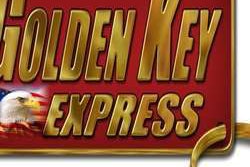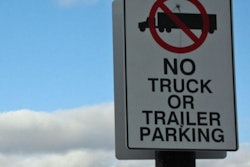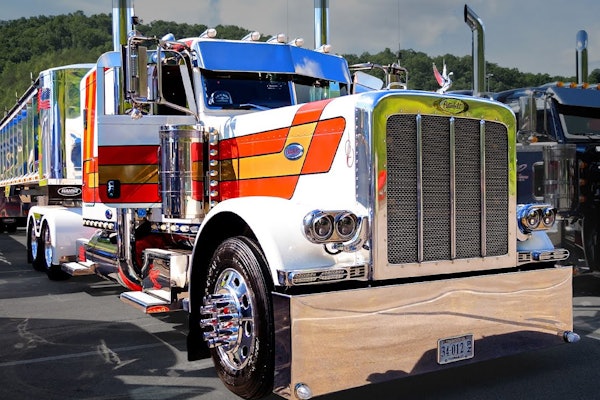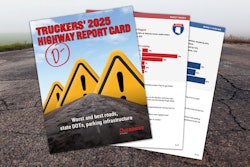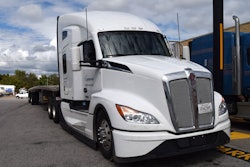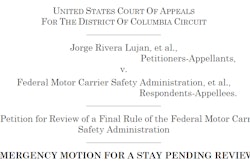Overdrive’s equipment editor finds the Cascadia seamlessly blends high-tech innovations, handling, performance and comfort.
The 108-degree wind felt like a hair dryer as we left the speedway just north of Las Vegas. I was driving one of six 2008 Cascadias 450 miles to Salt Lake City. Five pulled dry vans, all at about 78,000 pounds. Mine was a 72-inch condo, 125 inches BBC, with an Eaton Fuller 10-speed standard shift behind a 14-liter, 455-hp Detroit Diesel Series 60.
I immediately felt the benefits of the Cascadia’s rack-and-pinion steering, 50-degree steering cut and maximized visibility.
The steering is power-assisted mechanical instead of hydraulic, giving it a firmer, more definite feel. As for maneuverability, with the steering wheel cranked to the left stop, the Cascadia seemed to move sideways from a standing start.
The low-slung dashboard, large windshield and shortened, sloped hood combine for great visibility. I’m 6-foot-4 and keep the seat high, but all I saw of the hood was a thin line across the windshield’s lower edge.
The Exit 51 ramp on northbound I-15, northeast of Vegas, puts you on a 2 percent to 3 percent upgrade of 2.5 miles. From about 15 mph at the bottom of the ramp, the Series 60 got us to 60-plus mph before cresting the hill.

We frequently started some long, serious climbs north of Vegas at 65 mph, less momentum than we’d have at the 75 mph speed limit. The Series 60 proved that it was up to the challenge; 455 horsepower in 2008 equipment is as strong as it was in 2006, before the latest emissions regulations came into play.
We dropped below 45 mph two or three times, but we passed plenty of trucks, too. When we hit long, 4 percent-plus climbs at 75 mph and didn’t get slowed by traffic, I downshifted to ninth before the apex more as a formality than out of necessity.
Technology has taken the threat out of long, steep descents. With the engine brake and a few stabs on the air brake pedal, the long downhills became non-events. The Cascadia’s Jacobs engine brake made only a whooshing sound. Maybe the sophisticated new exhaust system quiets the engine brakes some, but the cab insulation no doubt helped, too.
I chose ninth gear for I-15’s twisty, up-and-down route along the Virgin River through Arizona’s Beaver Dam Mountains Wilderness. Here the rack-and-pinion steering was most evident. There was never any doubt I had a 39-ton semi, but the steering’s precise response made it handle like a much smaller vehicle. Soon I was back in 10th gear to keep up with my companions.
Shortly after crossing into Utah, we were treated to I-15’s gorgeous, mile-high drive across the rolling hills of Iron, Beaver and Millard counties, bordered by mountains on both sides. One of the wildfires that had closed I-15 the previous week still issued a smoke plume visible for miles.
During a break, I suggested we pick up the pace to make our goal of reaching Salt Lake City by dark. So we streaked along at 75 mph, and I found out how the Cascadia performs when driven harder.
At that speed in even a moderate crosswind, big trucks sometimes shake, shimmy and sway. But handling the Cascadia at 75 mph was like handling it at 65 mph, except we made better time. As we pulled into SLC, shadows from western mountains climbed the Wasatch Range to the east, and we got to the dealership just after dark.
Freightliner says it has spent millions on research and design for the Cascadia, focusing on lower operating costs and driver comfort. It shows. The truck takes the best of its predecessors and adds new ideas as well. It was fun and easy to drive, but it likely will show its true value in comfort, simplicity and savings.
Cascadia specs as tested
Truck: 2008 Cascadia 125-in. BBC with 72-in. raised roof sleeper
Engine: 455-hp Detroit Diesel Series 60, 1,550 lbs.-ft. torque
Engine brake: Jacobs
Transmission: 10-speed Eaton Fuller standard shift
Steering: Rack and pinion with sealed bushings
Steer axle: 12,000 lbs.
Drive axle: 40,000 lbs., 3:58
Air brake: Wabco anti-lock w/air dryer and heater
Brakes: Steer: Meritor 15 by 4 with ConMet drums; Drive: Meritor 16.5 by 7 with ConMet drums
Hubs: Steer and drive: ConMet PreSet aluminum bearings
Wheels: Steer and drive: Accuride 22.5-by-8.25 steel discs
Tires: Bridgestone 295/75R22.5
AC compressor: Sanden heavy duty
Bunk width: 40 in.
Wheel base: 232 in.
GVW: 78,000 lbs.
A CASCADE OF COMFORT
Freightliner makes much of the Cascadia’s overall comfort and ease of driving, and rightly so.
The doors and seats are longer and wider. The multi-position steering column offers more belly room. Cruise control, radio volume and running-light flasher are steering wheel-mounted. Cup holders come in two sizes.
The wraparound dash is easily within arm’s reach, and the controls are larger and easier to grab. The controls come in clusters that, similar to the gauges and headlight bulbs, install and remove easily and without tools.
Freightliner says its HVAC has 20 percent more cooling power, and I don’t doubt it. Even though it was 114 degrees at the Utah port of entry, I still got uncomfortably cool and adjusted the thermostat a few degrees.
The sleeper was roomy and comfortable, with space and power outlets for all the appliances: fridge, microwave, coffee maker, TV and DVD/VCR. A retractable work table can hold a laptop computer. The bunk had a thick mattress, and ample side window light added to the roomy feel.
The entire under-bunk space is storage. This and other spaces provide enough stowage for a team.
A LifeGuard Technologies option offers additional safety protection for driver and passenger. When a gyroscope senses a rollover, the seat drops to the floor, the seat belt and shoulder harness tighten, and an air bag inflates between the person’s head and the door.




